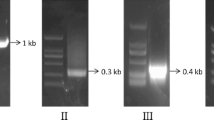Abstract
5-Enolpyruvylshikimate-3-phosphate synthase (EPSPS), the target enzyme for glyphosate inhibition, catalyzes an essential step in the shikimate pathway for aromatic amino acid biosynthesis. The full-length cDNA of 1,751 nucleotides (CaEPSPS, Genbank accession number: EU698030) from Convolvulus arvensis was cloned and characterized. The CaEPSPS encodes a polypeptide of 520 amino acids with a calculated molecular weight of 55.5 kDa and an isoelectric point of 7.05. The results of homology analysis revealed that CaEPSPS showed highly homologous with EPSPS proteins from other plant species. Tissue expression pattern analysis indicated that CaEPSPS was constitutively expressed in stems, leaves and roots, with lower expression in roots. CaEPSPS expression level could increase significantly with glyphosate treatment, and reached its maximum at 24 h after glyphosate application. We fused CaEPSPS to the CaMV 35S promoter and introduced the chimeric gene into Arabidopsis. The resultant expression of CaEPSPS in transgenic Arabidopsis plants exhibited enhanced tolerance to glyphosate in comparison with control.






Similar content being viewed by others
References
Gollub E, Zackin H, Sprinson DB (1967) Correlation of genes and enzymes, and studies on regulation of the aromatic path-way in Salmonella. J Biol Chem 242:5323–5328
Yi Y, Qiao D, Bai L, Xu H, Li Y et al (2007) Cloning, expression, and functional characterization of the Dunaliella salina 5-enolpyruvylshikimate-3-phosphate synthase gene in Escherichia coli. J Microbiol 45(2):153–157
Priestman MA, Funke T, Singh IM, Crupper SS, Schonbrunn E (2005) 5-Enolpyruvylshikimate-3-phosphate synthase from Staphylococcus aureus is insensitive to glyphosate. FEBS Lett 579:728–732
Schonbrunn E, Eschenburg S, Shuttleworth WA, Schloss JV, Amrhein N, Evans JN, Kabsch W (2001) Interaction of the herbicide glyphosate with its target enzyme 5-enolpyruvyl-shikimate-3-phosphate synthase in atomic detail. Proc Natl Acad Sci USA 98:1376–1380
James C (2012) Globle status of commercialized transgenic crops. ISAAA briefs no. 44. ISAAA, Ithaca 44
Howe AR, Gasser CS, Brown SM, Padgette SR, Hart J, Parker GB, Fromm ME, Armstrong CL (2002) Glyphosate as a selective agent for the production of fertile transgenic maize (Zea mays L.) plants. Mol Breed 10:153–164
Wang HY, Li YF, Xie LX, Xu P (2003) Expression of a bacterial aroA-M1, encoding 5-enolpyruvylshikimate-3-phosphate synthase for the production of glyphosate-resistant tobacco plants. Plant Res 116:455–460
Ye GN, Hajdukiewicz PT, Broyles D, Rodriguez D, Xu CW, Nehra N, Staub JM (2001) Plastid-expressed 5-enol-pyruvyl-shikimate-3-phosphate synthase genes provide high level glyphosate tolerance in tobacco. Plant J 25:261–270
Klee HJ, Muskopf YM, Gasser CS (1987) Cloning of an Arabidopsis thaliana gene encoding 5-enolpyruvylshikimate-3-phosphate synthase: sequence analysis and manipulation to obtain glyphosate-tolerant plants. Mol Gen Genet 210:437–442
Duncan K, Lewendon A, Coggins JR (1984) The complete amino acid sequence of Escherichia coli 5-enol-pyruvyl-shikimate-3-phosphate synthase. FEBS Lett 170:59–63
Garbe T, Jones C, Charles I, Dougan G, Young D (1990) Cloning and characterization of the aroA gene from Mycobacterium tumberculosis. J Bacteriol 172:6774–6782
Charles IJ, Keyte JW, Brammar WJ, Smith M, Hawkins AR (1986) Structure and nucleotide sequence of the complex AROM locus of Aspergillus nidulans. Nucleic Acids Res 14:2201–2213
Gasser CS, Winter JA, Hironaka CM, Shah DM (1988) Structure, expression and devolution of the 5-enol-pyruvyl-shikimate-3-phosphate synthase genes of Petunia and tomato. J Biol Chem 263:4280–4287
Ream JE, Steinrcken HC, Porter CA, Sikorsky JA (1988) Purification and properties of 5-enol-pyruvyl-shikimate-3-phosphate synthase from dark-grown seedlings of Sorghum bicolor. Plant Physiol 87:232–238
Forlanni G, Parisi B, Nielsen E (1994) 5-enol-pyruvyl-shikimate-3-phosphate synthase from Zea mays cultured cells. Plant Physiol 105:1107–1114
Xu JW, Feng DJ, Li XG, Chang TJ, Zhu Z (2002) Cloning of genomic DNA of rice 5-enolpyruvylshikimate-3-phosphate synthase gene and chromosomal localization of the gene. Sci. China 45:251–259
Gong Y, Liao Z, Chen M, Guo B, Jin H, Sun X, Tang K (2006) Characterization of 5-enolpyruvylshikimate 3-phosphate synthase gene from Camptotheca acuminate. Biol Plant 50(4):542–550
DeGennaro FP, Weller SC (1984) Differential sensitivity of field bindweed (Convolvulus arvensis) biotypes to glyphosate. Weed Sci 32:472–476
Cathala G, Savouret JF, Mendez B, West BL, Karin M, Martial JA, Baxter JD (1983) A method for isolation of intact, transcriptionally active ribonucleic acid. DNA 2:329–335
Tamura K et al (2011) MEGA5: molecular evolutionary genetics analysis using maximum likelihood, evolutionary distance, and maximum parsimony methods. Mol Biol Evol 28(10):2731–2739
Clough SJ, Bent AF (1998) Floral dip: a simplified method for Agrobacterium-mediated transformation of Arabidopsis thaliana. Plant J 16:735–743
Jefferson RA, Kavanagh TA, Bevan MW (1987) GUS fusion: beta-glucuronidase as a sensitive and versatile gene fusion marker in higher plants. EMBO J 6(13):3901–3907
Lescot M, Dehais P, Moreau Y, De Moor B, Rouze P, Rombauts S (2002) PlantCARE: a database of plant cis-acting regulatory elements and a portal to tools for in silico analysis of promoter sequence. Nucleic Acid Res 30:325–327
Steinrücken HC, Amrhein N (1980) The herbicide glyphosate is a potent inhibitor of 5-enolpyruvyl-shikimic acid-3-phosphate synthase. Biochem Biophys Res Commun 94:1207–1212
Nandula VK, Reddy KN, Rimando AM, Duke SO, Poston DH (2007) Glyphosate-resistant and susceptible soybean (Glycine max) and canola (Brassica napus) dose–response and metabolism relationships with glyphosate. J Agric Food Chem 55:3540–3545
Yuan Chiou-Ing, Chaing Mou-Yen, Chen Yih-Ming (2002) Triple mechanisms of glyphosate-resistance in a naturally occurring glyphosate-resistant plant Dicliptera chinensis. Plant Sci 163:543–554
Stallings WC, Abdel-Meguid SS, Lim LW, Shieh HS, Dayringer HE et al (1991) Structure and topological symmetry of the glyphosate target 5-enolpyruvylshikimate-3-phosphate synthase: a distinctive protein fold. Proc Natl Acad Sci USA 88:5046–5050
Shah D, Horsch R, Klee H, Kishore G, Winter J, Turner N, Hironaka C, Sanders P, Gasser C, Aykent S, Siegal N, Rogers S, Fraley R (1986) Engineering herbicide tolerance in transgenic plants. Science 233:478–481
Acknowledgments
We would like to thank Yuehui Chao from Institute of Animal Sciences, CAAS for assistance with transgenic plant culture and testing. We also appreciate the constructive and helpful comments on the manuscript from the editor and the anonymous reviewers.
Author information
Authors and Affiliations
Corresponding author
Rights and permissions
About this article
Cite this article
Huang, ZF., Zhang, CX., Huang, HJ. et al. Molecular cloning and characterization of 5-enolpyruvylshikimate-3-phosphate synthase gene from Convolvulus arvensis L.. Mol Biol Rep 41, 2077–2084 (2014). https://doi.org/10.1007/s11033-014-3056-2
Received:
Accepted:
Published:
Issue Date:
DOI: https://doi.org/10.1007/s11033-014-3056-2




